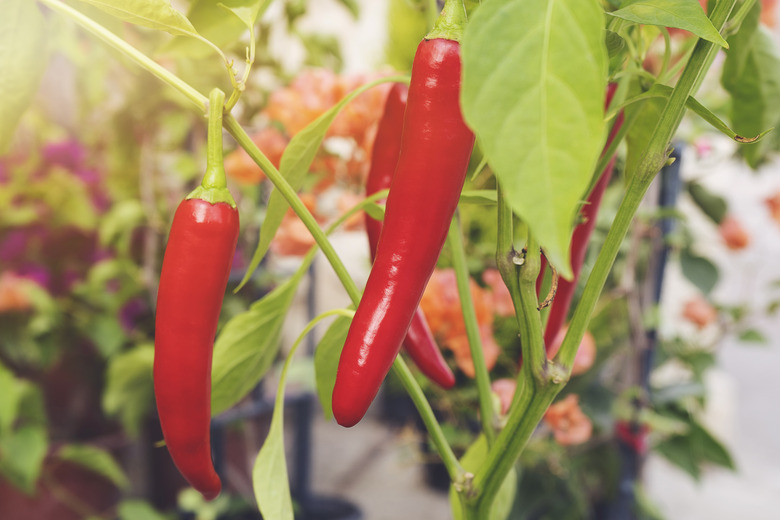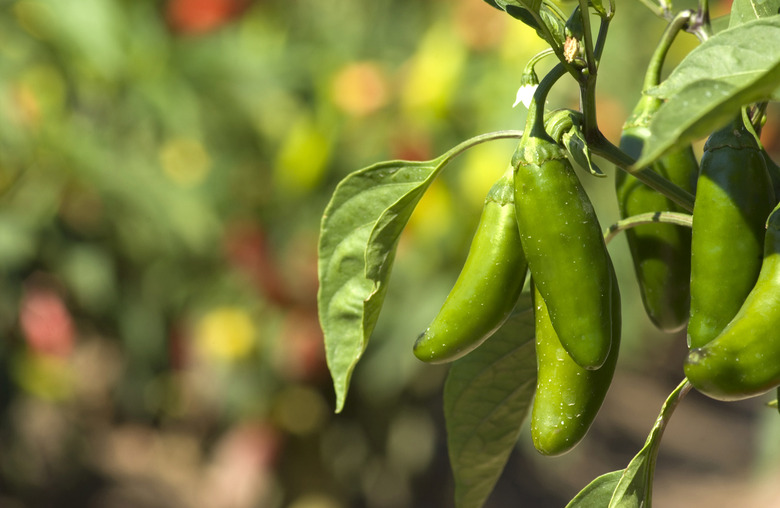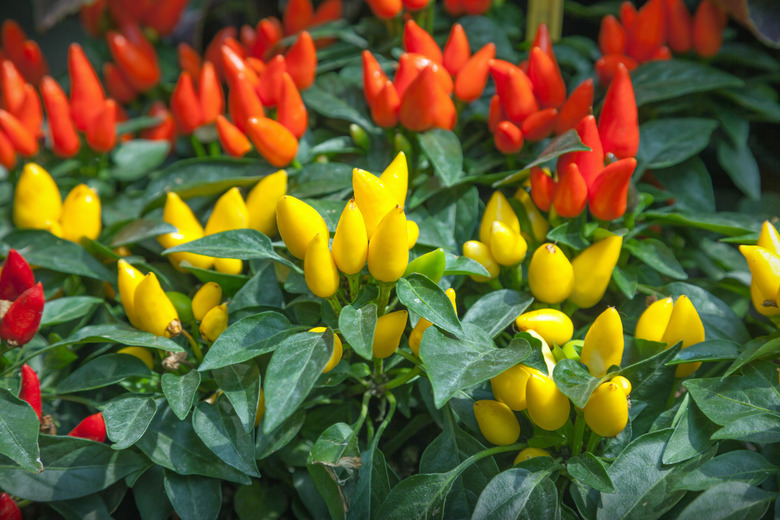How To Grow Hot Peppers
We may receive a commission on purchases made from links.
Some like their peppers sweet and juicy, and some like them hot. If you count yourself among the latter, you can choose from a wide array of hot peppers (Capsicum annuum) for your vegetable or herb garden. The cayenne pepper is one of the best known, but other popular hot pepper varieties include the spicy jalapeno, the more mild Anaheim and poblano peppers, and the hot chili pepper, to name a few. Some of the hottest peppers out there, such as the habanero pepper, the ghost pepper and the scorching Carolina reaper — which currently is the world's hottest pepper — constitute a separate species, but if you like the heat they offer, you can grow them in the same way you grow more mild ones.
The hot pepper plant has lush, green leaves and stems, and it grows about 3 feet high. Young peppers, which are the seed pods, are green, and some stay that way, but others turn vivid shades of yellow, orange and red as they ripen. The plant is a herbaceous perennial in its native tropical and subtropical habitat, but it can be grown as an annual in most U.S. climates. The length of the growing season varies with variety, and some ripen quickly enough to be grown during a very short summer.
Best Uses for Hot Peppers
Best Uses for Hot Peppers
Some peppers are just too hot to put on the table, but the plants on which they grow can be used effectively as decoration for your garden. The pepper plant grows about 3 feet high, so it won't dominate your garden, and the glossy, green, heart-shaped leaves create a pleasing contrast to the ripening yellow, orange and red peppers. If you don't live in a warm climate, you can grow peppers in containers on your porch and bring them indoors when the cold weather sets in.
Hot pepper plants need room to grow, and they need plenty of sun, but they also like to be close together so their leaves can protect the peppers from scorching on the hottest summer days. You can plant them with other vegetables that will shade the fruit during the hot days.
How to Grow Hot Peppers
How to Grow Hot Peppers
Starting Hot Peppers From Seed
In places where hot peppers are grown as annuals, seeds should be started indoors eight to 10 weeks before transplanting in the garden. Germinate them by placing each seed 1/4 inch deep in a small pot filled with seed-starting mix or between two damp paper towels placed inside a zipped plastic bag. The seeds need a constant temperature between 70 and 80 degrees Fahrenheit to germinate, so it's a good idea to put the pot or bag on a heat mat or on top of an appliance that generates heat, such as a refrigerator.
The seeds take about two weeks to germinate and another six to eight weeks to grow large enough to transplant. If you started your seeds in paper towels, plant them in potting soil as soon as they sprout. Using grow lights, give the seedlings 16 hours of light a day, water the soil when it dries out and apply a 50 percent concentration of liquid fertilizer every seven to 10 days.
Starting Hot Peppers From a Seedling
Because hot pepper seeds can be difficult to nurse into seedlings, many people go with store-bought pepper seedlings. Either way, they need a place in your garden that has loose, well-draining soil and gets at least six to eight hours of sun per day. If the soil is sandy or loamy, mix in some organic matter before planting, such as rotted compost.
Typical spacing is 12 to 24 inches, but that depends on variety, and the plants should go in at the same depth as they were in the pots. Each plant should have a stake for support because it can get heavy, especially when laden with peppers.
In What Zone Do Hot Peppers Grow Best?
In What Zone Do Hot Peppers Grow Best?
Hot peppers are at home in the tropics and will only grow as perennials in USDA zones 10 and 11, but gardeners in cooler zones can grow them as annuals. They can take anywhere from 55 to 150 days to bear fruit after transplanting, so the best variety for a particular region depends on the length of the growing season. If you grow peppers in containers that you can bring indoors, you can grow most varieties anywhere.
When Should You Plant Hot Peppers?
When Should You Plant Hot Peppers?
Hot peppers cannot tolerate cold and should only be planted when daytime temperatures remain above 65 degrees, and nighttime temperatures remain above 55 degrees, which is typically two weeks after the last frost. In colder climates, it's a good idea to warm the soil by setting out plastic mulch 10 to 14 days before transplanting. Because the weather can be unsettled in spring, it's also a good idea to erect hoop tunnels over the young plants and cover them with plastic to help retain heat. Just remember to remove the plastic when the weather is reliably warm.
Soil, Sunlight and Water Recommendations for Hot Peppers
Soil, Sunlight and Water Recommendations for Hot Peppers
The hot pepper plant prefers loose, well-draining, slightly acidic soil with a pH between 6.0 and 6.8, and other than that, it isn't particularly fussy. To ensure it gets some of the nutrients it needs, you should mix some well-rotted compost or worm castings into the soil before planting. Apply fertilizer at soil-test recommendations to make sure your pepper plants grow and bear fruits to their potential.
The young seedlings need to be watered regularly until they show new leaves, at which point you can reduce watering to twice a week or whenever the soil feels dry. The plants need to be in full sun and will benefit from an application of straw or some other organic mulch to help the soil retain moisture. When spreading mulch, keep it an inch or two away from the plant stems to discourage fungal rots and other insect and disease problems.
How to Propagate Hot Peppers
How to Propagate Hot Peppers
The most common way to propagate hot peppers is by seed, although experienced gardeners may also root stem cuttings. You can purchase hot pepper seeds online or from your local garden center, but you can also obtain them from the peppers. They don't contain any capsaicin themselves, but the fibers holding them to the seed pod contain the highest concentration of this irritant in the entire pepper, so be careful when extracting them. Avoid prolonged contact, wash your hands and never, ever rub your eyes after handling peppers.
How to Winterize Hot Peppers
How to Winterize Hot Peppers
Hot peppers won't survive freezing temperatures, so if you live in a cold climate and you want to raise them as perennials, you have to bring them indoors when the temperature falls below their comfort zone. Put the container next to a sunny window or if you don't have one, put it under grow lights.
How to Harvest Hot Peppers
How to Harvest Hot Peppers
Peppers can take a long time to grow, and some of the hottest aren't ready until 150 days after transplanting. The fruits of most hot peppers turn from green to yellow to orange to red as they ripen, and they should remain on the plant while this happens to ensure the best taste.
In general, you want to pick the peppers while they are plump and full size and before they start to shrivel, but picking them early encourages the plant to produce more. Pruning the pepper plants also helps increase production.
The branches are fragile and will break if you tug on them, so use a pair of secateurs to cut the stems. Wear gloves and don't touch your eyes or mouth until after you've washed your hands with soap.
Common Pests and Other Problems for Hot Peppers
Common Pests and Other Problems for Hot Peppers
Insects damage pepper leaves and may also eat the peppers, and they can do a lot of damage if you don't catch them early.
- Aphids collect on the leaves and cover them with sticky honeydew, which can promote mold growth and attract ants. Spray the plants with water to dislodge them or for severe infestations, treat the plants with insecticidal soap.
- Cutworms, which are the larvae of night-flying moths, spend their days in the soil and eat the stems of your pepper plants at night. Tilling the soil before planting, weeding and removing debris from the garden are good ways to keep cutworms away.
- Flea beetles hop around the leaves and make short work of them, leaving small holes that ruin the appearance of your decorative pepper plants. Erecting hoop tunnels over the young plants and mulching the soil are two good ways to keep these pests away, but if they are already there, treat them like roaches and use an insecticidal dust.
- Loopers are fairly large, green caterpillars that dine on the leaves. They are easy to spot, and the best way to remove them is to simply pick them off with your fingers.
Common Diseases for Hot Peppers
Common Diseases for Hot Peppers
Perhaps because they like dry conditions that pathogens tend not to like, pepper plants aren't affected by many diseases. They are vulnerable to a few, though:
- Phytophthora root rot is a disease caused by an algae-like organism known as an oomycete. Affected plants wilt and die, and once the disease has struck, there's little you can do. It's caused by overwatering and can be prevented by planting on mounds or in large containers to improve drainage and watering only when necessary.
- Anthracnose is a fungal infection that can form ugly lesions on the leaves and the peppers. If you spot it early, you may be able to limit damage by spraying the plants with a fungicide, but in severe cases, affected plants should be removed.
- Mosaic virus is transmitted by aphids, which is another good reason to control these tiny pests that affect so many leafy plants. It curls and wrinkles the leaves and stunts overall plant growth, and once these symptoms appear, there's nothing you can do. Prevent this disease by eliminating aphids as soon as you see them.


